Delta Air Lines: Navigating Turbulence with Operational Fortitude and Strategic Focus
Delta Air Lines (DAL) has emerged as a bellwether of resilience in the post-pandemic travel sector, leveraging strategic capacity adjustments, premium revenue growth, and disciplined cost management to navigate an environment of economic uncertainty. As summer travel demand surges, the airline's Q1 2025 results and forward guidance underscore its ability to capitalize on high-margin opportunities while safeguarding shareholder returns. For investors, this combination of operational rigor and sector leadership positions DAL as a compelling play on the aviation recovery.

Financial Fortitude Amid Shifting Winds
Delta's Q1 2025 operating revenue of $14.0 billion marked a 3.3% year-over-year increase, driven by robust performance in premium and loyalty segments. Premium revenue rose 7%, while international bookings grew at mid-single-digit rates, with the Pacific region surging 16%. This outperformance reflects Delta's focus on high-margin routes and partnerships like its American Express credit card collaboration, which contributed $1.9 billion in revenue—a 9% year-over-year jump.
Despite these gains, domestic and leisure demand faced headwinds. Corporate travel growth moderated as companies reined in spending, and leisure bookings softened, particularly in U.S.-bound markets like Canada and Mexico. To address overcapacity concerns, Delta slashed its 2025 capacity growth forecast from 3-4% to flat year-over-year, deferring Airbus deliveries and aligning supply with demand. This proactive approach helped stabilize yields, with pre-tax income hitting $320 million and adjusted EPS of $0.46—exceeding analysts' $0.38 estimate.
Demand Dynamics: A Two-Speed Recovery
Delta's Q1 results highlight a stark divide between premium and mainstream travel. While business and first-class cabins thrived, domestic main cabin revenue lagged as carriers like Southwest and JetBlue flooded routes with discounted fares. Yet, the airline's premium strategy—bolstered by partnerships with luxury brands like Missoni (whose designs now grace Delta's premium cabins)—positions it to capture the 10% year-over-year growth in premium travel demand.
Leisure travel, too, shows promise. Despite February-March softness, Delta noted a 10% demand spike at the start of 2025, a trend likely to accelerate with summer travel. Management's decision to maintain flat capacity growth through Q2/Q3—compared to 5-6% growth in 2024—aims to protect yields during peak seasons.
Cost Discipline and Dividend Sustainability
Delta's non-fuel unit costs rose 2.6% year-over-year, driven by labor and maintenance expenses. However, its $2.4 billion operating cash flow and $4 billion free cash flow target for 2025 underscore liquidity strength. The airline's $0.15 quarterly dividend, unchanged since mid-2023, remains sustainable with a payout ratio of just 10% of adjusted EPS.
Analysts emphasize that Delta's focus on free cash flow allocation—prioritizing dividends and buybacks—aligns with investor preferences for stability. With a trailing dividend yield of 0.8% (vs. an industry average of 1.2%), DAL offers modest but consistent returns, amplified by its stock's 23% year-to-date outperformance over broader markets in 2024.
Why Invest Now?
Delta's strategic moves—shrinking capacity, prioritizing premium segments, and maintaining dividends—position it to capitalize on the summer travel boom while insulating against economic volatility. Key catalysts include:
1. Summer Travel Surge: Strong booking trends for July/August, particularly in transatlantic and transpacific markets.
2. Fleet Efficiency: Delta's modern fleet (average age 10.5 years) and route optimization reduce fuel intensity.
3. Sector Leadership: As legacy carriers like American and United grapple with overcapacity, Delta's agility in trimming supply could widen its margin advantage.
Historical data reinforces this outlook: when Delta's earnings beat expectations, a buy-and-hold strategy for 30 days delivered an average return of 16.59%, outperforming the benchmark by over 3 percentage points. While volatility reached 14.46%, the strategy's resilience underscores its potential during positive earnings surprises.
Risks and Considerations
Tariffs on aerospace components and lingering labor cost pressures (up 8% in Q1) pose near-term challenges. However, Delta's Q2 guidance of $1.5–$2.0 billion profitability, paired with its $4 billion free cash flow target, suggests management has sufficient buffers to navigate these headwinds.
Conclusion: A Flight to Stability and Growth
Delta Air Lines is a rare blend of defensive stability and offensive growth potential in an uneven recovery. Its ability to prioritize premium segments, manage costs, and maintain dividends amid sector turbulence makes it a compelling buy for investors seeking exposure to travel's resurgence. With summer bookings on track and a disciplined strategy intact, DAL is primed to outperform as the aviation sector takes flight.
Historical performance further bolsters this thesis: backtesting from 2020 to 2025 shows that when Delta's earnings exceed expectations, a 30-day hold strategy produced a 16.59% return, outperforming the benchmark by 3.17%, despite moderate volatility. This underscores the stock's potential to capitalize on positive news, making it a compelling choice for investors.
The time to board this opportunity is now.

Comments
No comments yet